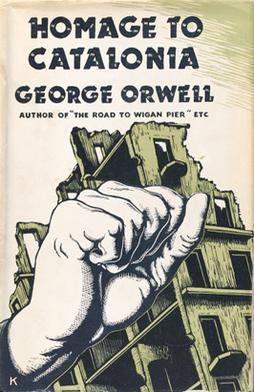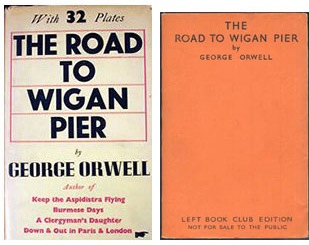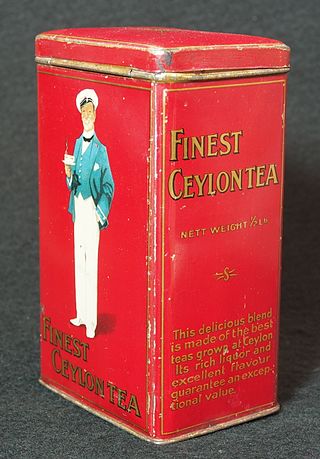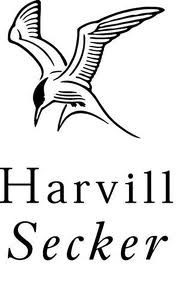
Animal Farm is a beast fable, in the form of a satirical allegorical novella, by George Orwell, first published in England on 17 August 1945. It tells the story of a group of anthropomorphic farm animals who rebel against their human farmer, hoping to create a society where the animals can be equal, free, and happy. Ultimately, the rebellion is betrayed, and under the dictatorship of a pig named Napoleon, the farm ends up in a state as bad as it was before.

Eric Arthur Blair, better known by his pen name George Orwell, was an English novelist, essayist, journalist, and critic. His work is characterised by lucid prose, social criticism, opposition to totalitarianism, and support of democratic socialism.

Homage to Catalonia is George Orwell's personal account of his experiences and observations fighting in the Spanish Civil War for the POUM militia of the Republican army.

The Road to Wigan Pier is a book by the English writer George Orwell, first published in 1937. The first half of this work documents his sociological investigations of the bleak living conditions among the working class in Lancashire and Yorkshire in the industrial north of England before World War II. The second half is a long essay on his middle-class upbringing, and the development of his political conscience, questioning British attitudes towards socialism. Orwell states plainly that he himself is in favour of socialism, but feels it necessary to point out reasons why many people who would benefit from socialism, and should logically support it, are in practice likely to be strong opponents.

"Politics and the English Language" (1946) is an essay by George Orwell that criticised the "ugly and inaccurate" written English of his time and examined the connection between political orthodoxies and the debasement of language.
Sonia Mary Brownell, better known as Sonia Orwell, was the second wife of writer George Orwell. Sonia is believed to be the model for Julia, the heroine of Nineteen Eighty-Four.

A Clergyman's Daughter is a 1935 novel by English author George Orwell. It tells the story of Dorothy Hare, the titular clergyman's daughter, whose life is turned upside down when she suffers an attack of amnesia. It is Orwell's most formally experimental novel, featuring a chapter written entirely in dramatic form, but he was never satisfied with it and he left instructions that after his death it was not to be reprinted. Despite these instructions, Orwell did consent to the printing of cheap editions "of any book which may bring in a few pounds for my heirs" following his death.

"A Nice Cup of Tea" is an essay by English author George Orwell, first published in the London Evening Standard on 12 January 1946. It is a discussion of the craft of making a cup of tea, including the line: "Here are my own eleven rules, every one of which I regard as golden."
"Such, Such Were the Joys" is a long autobiographical essay by the English writer George Orwell.

Harvill Secker is a British publishing company formed in 2005 from the merger of Secker & Warburg and the Harvill Press.

Fredric John Warburg was a British publisher, who in 1935 founded the company Secker & Warburg. He is best known for his association with the author George Orwell. During a career spanning a large part of the 20th century and ending in 1971, Warburg published Orwell's major books Animal Farm (1945) and Nineteen Eighty-Four (1949), as well as works by other leading figures such as Thomas Mann and Franz Kafka. Other notable publications included The Third Eye by Lobsang Rampa, Pierre Boulle's The Bridge over the River Kwai, Adolf Hitler's Mein Kampf and William Shirer's The Rise and Fall of the Third Reich.
Searchlight Books was a series of essays published as hardback books, edited by T. R. Fyvel and George Orwell. The series was published by Secker & Warburg.
"Politics vs. Literature: An Examination of Gulliver's Travels" is a critical essay published in 1946 by the English author George Orwell. The essay is a review of Gulliver's Travels with a discussion of its author Jonathan Swift. The essay first appeared in Polemic No 5 in September 1946.
"Some Thoughts on the Common Toad" is an essay published in 1946 by the English author George Orwell. It is a eulogy in favour of spring.

The bibliography of George Orwell includes journalism, essays, novels, and non-fiction books written by the British writer Eric Blair (1903–1950), either under his own name or, more usually, under his pen name George Orwell. Orwell was a prolific writer on topics related to contemporary English society and literary criticism, who has been declared "perhaps the 20th century's best chronicler of English culture." His non-fiction cultural and political criticism constitutes the majority of his work, but Orwell also wrote in several genres of fictional literature.

Nineteen Eighty-Four is a dystopian novel and cautionary tale by English writer George Orwell. It was published on 8 June 1949 by Secker & Warburg as Orwell's ninth and final book completed in his lifetime. Thematically, it centres on the consequences of totalitarianism, mass surveillance and repressive regimentation of people and behaviours within society. Orwell, a democratic socialist, modelled the authoritarian state in the novel on the Soviet Union in the era of Stalinism, and Nazi Germany. More broadly, the novel examines the role of truth and facts within societies and the ways in which they can be manipulated.
The English People is an essay by English author George Orwell, first published in August 1947. It was commissioned in September 1943 by W. J. Turner, Collins's general editor, for the series Britain in Pictures. The idea for the series came from the Ministry of Information. It was published with twenty-five illustrations, eight of which were full-page colour plates, and included work by artists Edward Ardizzone, Dame Laura Knight, L. S. Lowry, Henry Moore, John Minton, and Feliks Topolski. Written during World War II, it presents Orwell's vision of what it meant to be "English".
Peter Hobley Davison OBE was a British professor of English and an authority on the life and works of George Orwell.
Ian Angus was a British librarian and a scholar on George Orwell.

"Reflections on Gandhi" is an essay by George Orwell, first published in 1949, which responds to Mahatma Gandhi's autobiography The Story of My Experiments with Truth. The essay, which appeared in the American magazine Partisan Review, discusses the autobiography and offers both praise and criticism to Gandhi, focusing in particular on the effectiveness of Gandhian nonviolence and the tension between Gandhi's spiritual worldview and his political activities. One of a number of essays written by Orwell and published between Animal Farm (1945) and Nineteen Eighty-Four (1949), "Reflections on Gandhi" was the last of Orwell's essays to be published in his lifetime and was not republished until after his death.










